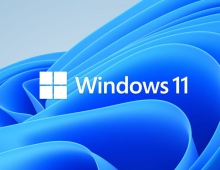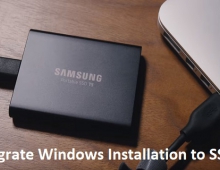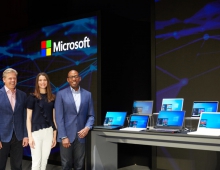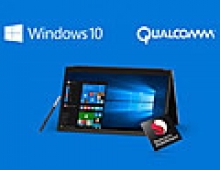Windows XP Professional x64 Edition
18. Application Benchmarks - Science Mark 2
Review Pages
2. System Specifications
3. Product Overview
4. Compatibility
5. Security Issues
6. Gaming Experience
7. Availability And Price
8. Windows Installation
9. Drivers Installation
10. Test System
11. Game Benchmarks - Far Cry
12. Game Benchmarks - Colin McRae 2005
13. Game Benchmarks - Half Life 2
14. Application Benchmarks - 3DMark2003
15. Application Benchmarks - 3DMark2005
16. Application Benchmarks - PCMark04
17. Application Benchmarks - SiSoftware Sandra 2004
18. Application Benchmarks - Science Mark 2
19. Application Benchmarks - Pov-Ray
20. Conclusion
21. Drivers Availability
22. Programs that are not supported
 Science Mark 2.0 is an attempt to put the truth behind benchmarking. In an attempt to model real world demands and performance, SM2 is a suite of high-performance benchmarks that realistically stress system performance without architectural bias. Synthetic benchmarks are useful, and can tell the user valuable performance characteristics about their system's performance, but they should not be used in entirety to measure system performance; this role is reserved in greater part to real applications performing real tasks. Science Mark 2.0 is comprised of 7 benchmarks, each of which measures a different aspect of real world system performance. According to sciencemark.org, the codes in Science Mark 2.0 were architected with general system performance considerations before they were implemented.
Science Mark 2.0 is an attempt to put the truth behind benchmarking. In an attempt to model real world demands and performance, SM2 is a suite of high-performance benchmarks that realistically stress system performance without architectural bias. Synthetic benchmarks are useful, and can tell the user valuable performance characteristics about their system's performance, but they should not be used in entirety to measure system performance; this role is reserved in greater part to real applications performing real tasks. Science Mark 2.0 is comprised of 7 benchmarks, each of which measures a different aspect of real world system performance. According to sciencemark.org, the codes in Science Mark 2.0 were architected with general system performance considerations before they were implemented.
Let's take a more detailed look at each benchmark test and what it does:
"MemBench" - An unbiased, synthetic benchmark that sweeps through more than 15 different, publicly available, memory copy algorithms to measure the peak memory performance of your CPU’s caches and your memory subsystem.
"BlasBench" - Scientists and engineers use large matrix multiplication to determine peak MFLOPS. BlasBench measures the MFLOPS of your machine via large matrix multiplication. The benchmark can be run in single or double precision. Real world matrices are often large and don't fit into the processor's cache. Science Mark 2’s optimized implementations of matrix multiplication in single and double precision, from an algorithm point of view, perform remarkably better than the blind man's matrix multiplication routine. BlasBench uses building blocks called kernels at its lowest level that determine overall MFLOPS performance. These kernels are written in C and a wide assortment of assembly forms (SSE Vector, SSE2 Vector, SSE2 Scalar, x87, 3DNow! Vector) to support any processor architecture in the x86 market.
"MolDyn" - Science Mark 2.0 performs Molecular Dynamics Simulations. It has the flexibility of simulating any 5 noble gases, in 3 different crystallographic configurations, with variable numbers of atoms at a user specified temperature.
"Primordia" - Science Mark 2.0 computes the electronic orbitals for the atoms between Hydrogen and Promethium in the periodic table using a Restricted Hartree-Fock method. Primordia outputs the total all electron energy of the atom in addition to the kinetic and potential contributions. The user is allowed to specify different grids upon which the orbitals are determined.
"QMC" - The Primordia orbitals are utilized to simulate and determine the properties of molecules using the extremely accurate quantum Monte Carlo algorithm. Primordia and QMC are indicative of what is done in commercial chemistry codes on workstations and supercomputers about the world.
"FEM" - The behavior and properties of fluids and structures is modeled using the Finite Element Method. Similar tasks are performed by automotive, aerodynamic and civil engineering companies during their product design.
"Cipher" - Benchmark tests four different forms of encryption algorithms, AES 128/256 bit and RSA 512/1024 bit. Sean's AES 128 bit encryption algorithm is quite possibly the fastest implementation on the face of the earth.
Score is weighted thus:
(((Memory Score + Stream Score) / 2) + Cryptography Score + Molecular Dynamics Score + Primordia Score + BLAS Score) / 5
Unfortunately the final version of ScienceMark 2 for Windows x64 Edition is still beta. According to the developer, performance may change in the future depending on how they tune for fp performance. We should see significant speedups on both EM64T and AMD64 processors in 64-Bit mode. Part of this will be due to compiler improvements. : Intel EM64T systems are supported, however, ScienceMark2 won't be able to detect them properly in MemBench at this time. This will be remedied in a future version. Also, CipherBench is not supported in 64-Bit mode at this time. This will be remedied in a future version. The graph below shows us the results of the 32-Bit version of this program that we ran under Windows XP Professional and the results of the 64-Bit version that we ran under Windows XP Professional x64 Edition.
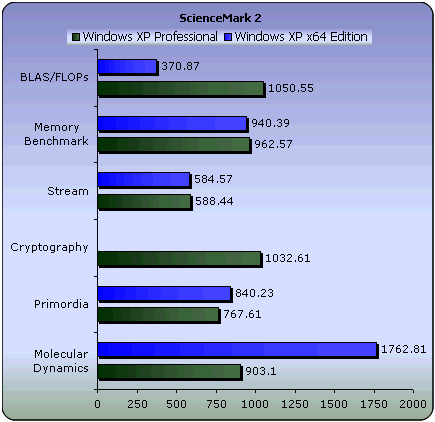
As we mentioned before, the Cryptography Benchmark (CipherBench) is not available at this time for the 64-Bit version of this program. This is the first test where we use a 64-bit version and we managed to see significant performance increases. In the molecular Dynamics Benchmark, notice the awesome performance difference of 49%. We can understand that this result is due to the fact that in the 64-Bit architecture, a lot of procedures are completed in less time. Also, in the Primordia test, we have an increase of 9%.
However, in the BLAS/FLOPs test we can see that the Windows XP x64 drops to under 35% but if we consider that this is still a beta program we can expect improvements in a future, stable release. (The improvements of course will concern improved scores and not the opposite).
Review Pages
2. System Specifications
3. Product Overview
4. Compatibility
5. Security Issues
6. Gaming Experience
7. Availability And Price
8. Windows Installation
9. Drivers Installation
10. Test System
11. Game Benchmarks - Far Cry
12. Game Benchmarks - Colin McRae 2005
13. Game Benchmarks - Half Life 2
14. Application Benchmarks - 3DMark2003
15. Application Benchmarks - 3DMark2005
16. Application Benchmarks - PCMark04
17. Application Benchmarks - SiSoftware Sandra 2004
18. Application Benchmarks - Science Mark 2
19. Application Benchmarks - Pov-Ray
20. Conclusion
21. Drivers Availability
22. Programs that are not supported



